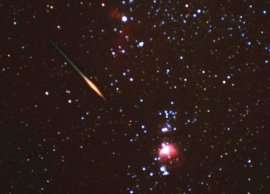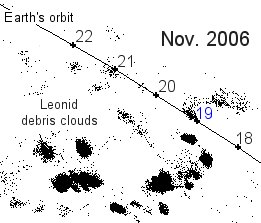Return of the Leonids

On Sunday, Nov. 19th, Earth will pass through a stream of debris from comet 55P/Tempel-Tuttle. The result: a shower of Leonid meteors.
"We expect an outburst of more than 100 Leonids per hour," says Bill Cooke, the head of NASA's Meteoroid Environment Office in Huntsville, AL. This pales in comparison to the Leonid storms of 2001 and 2002, when sky watchers saw thousands of meteors. Even so, a hundred per hour would make the Leonids one of the best showers of 2006.
The problem is, you have to be in the right place at the right time to see them.
Earth's encounter with the comet dust is going to be brief—"possibly no more than a few hours long," says Cooke. Forecasters differ on when the outburst will occur. Estimates range from 0445 UT to 0630 UT on Nov. 19th (11:45 p.m. on Nov. 18th to 1:30 am EST on Nov. 19th). The timing favors western Europe, Africa, Brazil and eastern parts of North America: map.
Cooke urges observers to find the darkest possible skies. "These Leonids are going to be faint." Why? "The stream contains very small grains of comet dust. Small grains make faint meteors--it's as simple as that."

The mid-November region of Earth's orbit is littered with debris from Comet Tempel-Tuttle. Every time the comet visits the inner solar system (once every 33 years), it lays down a new stream of dust, pebbles and rock. This creates a sort of "minefield" for Earth to navigate every November.
Not all of these debris streams are alike. For example: "A Leonid stream we hit in 1998 was full of rock-sized debris. They made brilliant fireballs when they hit the atmosphere," recalls Cooke. "The stream we're hitting this year is just the opposite. It's mostly fine dust."
Debris streams are segregated—dusty vs. rocky—by the force of sunlight. Consider the stream directly ahead of us: "It was ejected from the comet in 1933," says Cooke. "At first, the debris was a mixture of many sizes." But as years passed, the smaller particles diverged from the larger ones. Radiation pressure—the delicate pressure of sunlight itself—pushed the light dust onto a collision course with Earth. Heavier rock-sized fragments resisted the pressure and lagged behind.
Perhaps in some future year we'll encounter the larger debris from 1933 and receive an overdue display of fireballs. How would they get here? "Nudged by Jupiter," suggests Cooke. Jupiter's gravity is strong enough to alter the course of heavier fragments. Indeed, by guiding debris toward us, Jupiter is indirectly responsible for many bright Leonid displays in the past.
But this is 2006. So prepare for an outburst of faint Leonids.
Extra: Don't believe everything you read. While meteor forecasters have done a splendid job predicting Leonid outbursts in recent years—sometimes "nailing the peak within minutes"—they could be wrong in 2006. The outburst might happen at an unexpected time or it might be better than expected. Cooke urges enthusiasts everywhere to keep an eye out for Leonid meteors the nights of Nov. 17th – 19th. "The best time to look," he says, "is just before local dawn when the constellation Leo is high in the sky."
Source: Science@NASA, by Dr. Tony Phillips




















